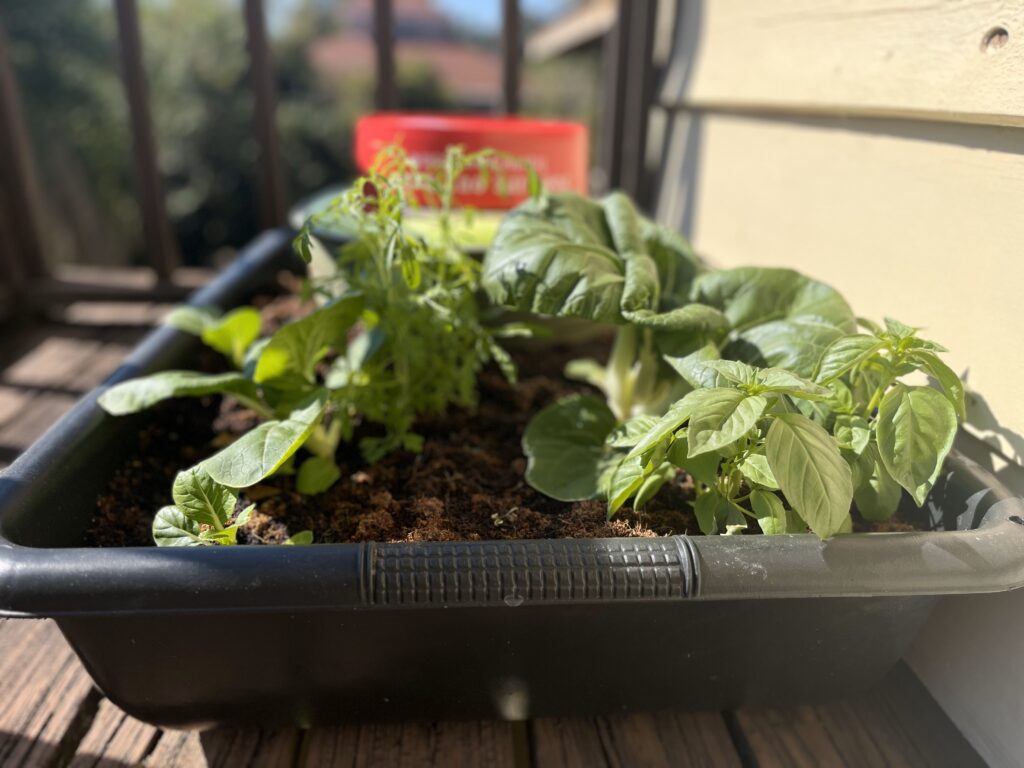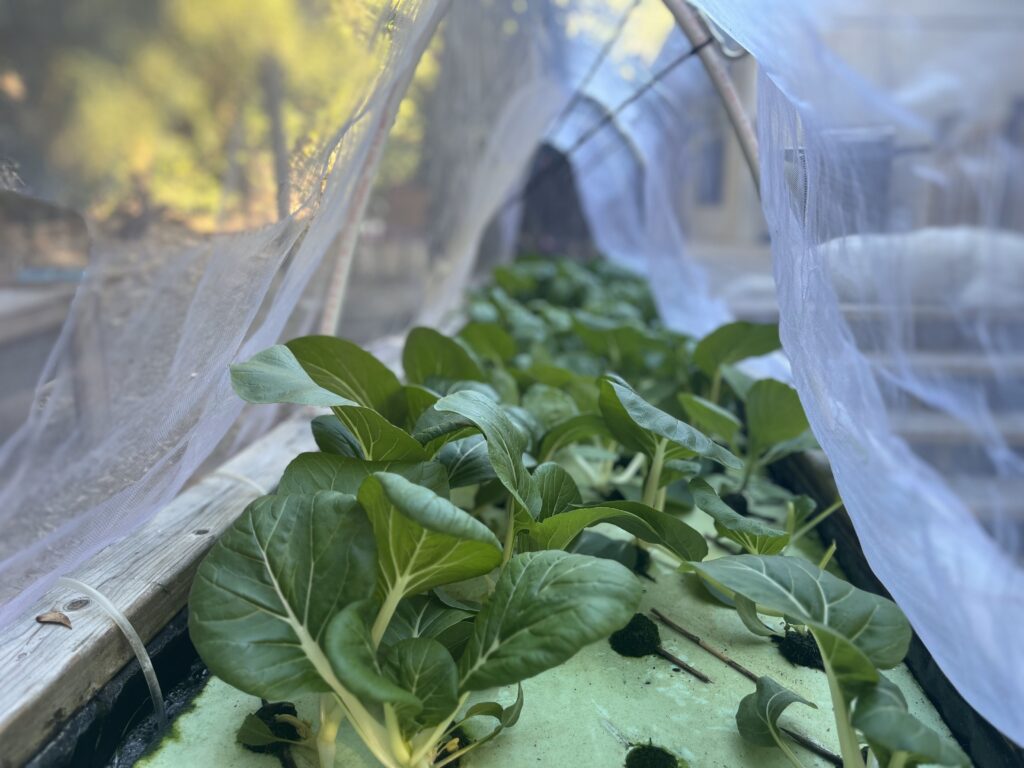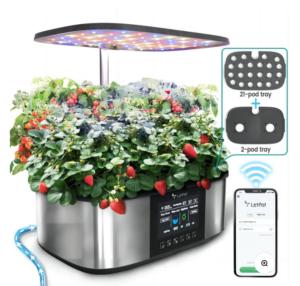Outdoor hydroponics offers a unique and rewarding approach to soil-free gardening, leveraging natural sunlight and space to grow plants without soil. With a few adjustments to accommodate the elements, you can create a productive and sustainable hydroponic system in your backyard, on balconies, or other open areas. From passive setups like the Kratky method to more active systems like nutrient film technique (NFT), there’s a method for every outdoor environment.
If you’re interested in learning more about outdoor hydroponic systems, as well as off-grid setups, check out our online course Off-Grid Hydroponics. The course includes hands-on demonstrations of various methods, including the Candlestick, and provides detailed instructions on creating your own systems. Additionally, you can explore the Hydroponics Hobby Center, or take our online course Hydronics 101: Learn, Design, and Build Your Own System.
Indoor vs Outdoor Hydroponics
The main difference between indoor and outdoor hydroponics is (wait for it…) one’s done outside, and one’s done inside (who’d have thought?). But on a more serious note, yes, there’s more to consider than just location.
In fact, because we’re growing outside, under direct sunlight in the big beautiful outdoors, there’s a lot to think about. And what you do impacts everything—from environmental control to plant management and maintenance routines. Outdoors, you’re dealing with natural variables like temperature fluctuations, rain, wind, and pests, all of which require extra attention to keep plants thriving.

Advantages of Outdoor Systems
- Free Sunlight: Nothing beats free sunlight for growth; it’s full-spectrum and, best of all, costs nothing.
- More Room: Outdoors, space is almost unlimited! Grow on rooftops, backyards, or wherever you have some solid ground.
- Free Rain (if that applies to you): Rainwater can help keep reservoirs topped up naturally, saving on water usage. Just keep an eye on nutrient levels.
- Natural Pollination: Pollinators like bees do the hard work for you, making fruiting plants more productive.
- Natural Breeze: Outdoor breezes help strengthen stems, keeping plants sturdy against the elements.
- Worry-Free Mess: Outdoors, spills and splashes don’t matter, so there’s less hassle and clean-up compared to indoor setups.
- Lower Startup Costs: Outdoor hydroponics skips on grow lights, HVAC, and other gear, so your budget stretches a bit further.
Disadvantages of Outdoor Systems
- Weather Exposure: Sun, rain, and temperature swings mean outdoor systems need extra monitoring for nutrient and water balance.
- Pests: Bugs and critters are unavoidable outside, so pest management becomes a priority.
- Temperature Fluctuations: Your water temps can change fast outside. In hot weather, your reservoir might need insulation to stay in the safe zone.
- Rainwater Control: Rain can dilute your nutrients fast. If needed, consider placing a roof or overhang to keep it manageable.
- Algae Growth: With sunlight comes algae. You’ll need to keep parts of your system shaded to avoid that pesky green growth in your water.
- Can’t Grow Year-Round: Unlike indoor hydroponics, you have to follow soil-based gardening calendars, limiting when/what you can grow.
Best Outdoor Hydroponic Systems
Kratky
The Kratky method is a simple, passive system that doesn’t require pumps or electricity, making it great for outdoor use. In this setup, plant roots hang down into a nutrient solution in a reservoir, and as the plants consume the solution, airspace is created for oxygenation. Just set it up and let the plants do their thing. [Read more about the Kratky Method here]
Deep Water Culture (DWC)
DWC involves suspending plants in a nutrient solution while air pumps provide oxygen directly to the roots, allowing for steady growth. Perfect for outdoor growing with minimal upkeep. Just make sure your reservoir is insulated/shaded to prevent temperature swings and keep that oxygen pumping to the roots. [Read more about Deep Water Culture here]
Drip Systems
In drip hydroponics, nutrient solution is delivered directly to each plant’s root zone via drip emitters. This targeted watering method works wonders outside because it’s precise and flexible. You can time the emitters to conserve water and reduce evaporation. [Read more about Drip Systems here]
Ebb and Flow (Flood and Drain)
This system involves periodically flooding a grow bed with nutrient solution, then draining it back into a reservoir. Ebb and Flow adapts well outdoors if shielded from excess rain, which can mess with the rise and fall of the water and cause a nutrient imbalance. [Read more about Ebb and Flow Systems here]
Nutrient Film Technique (NFT)
NFT works by creating a shallow film of nutrient solution that flows continuously over plant roots, giving them access to both nutrients and oxygen. Although common in both indoor and outdoor setups, NFT are particularly well-suited for outdoor growing under the right conditions. [Read more about the Nutrient Film Technique here]
Aeroponics
Aeroponics involves suspending plants in the air and misting the roots with a fine nutrient solution, maximizing oxygen exposure. While it’s usually done indoors due to the need for consistent environmental controls, there are several variations, like aeroponic tower gardens, that can thrive outdoors with the right protection. [Read more about Aeroponics here]
Wicking Systems
Wicking systems use a wick (picture a piece of fabric) to draw nutrients up from a reservoir to the plant roots, relying on capillary action. Wicking isn’t always ideal outdoors, but some variations, like the Candlestick system, are perfectly suited for outdoor setups as long as they’re covered from rain. [Learn more about the Candlestick system here]

Outdoor Considerations
Following Gardening Calendars
If you’re growing hydroponically outdoors, it’s best to follow traditional gardening calendars, planting what’s in season at the right time. Outdoor hydroponics gives a bit more flexibility since your reservoir temperature can differ slightly from soil temperature, but sticking to soil-based planting schedules will ensure your plants survive.
Protective Netting
Outdoor hydroponic systems can benefit greatly from protective netting. Netting helps shield plants from pests, such as birds and larger insects, without the need for pesticides. It can also reduce damage from wind and minimize leaf burn from intense sunlight. Additionally, netting provides light shading, helping to keep temperatures consistent and protecting delicate plants. When setting up netting, choose UV-resistant materials to ensure durability in outdoor conditions, and secure it tightly to avoid gaps where pests can sneak through.

Placement
Choosing the right location for your outdoor hydroponic system is crucial for success. Ideally, place your setup where it will receive adequate sunlight—most plants thrive with at least 6–8 hours of direct sun. For hotter climates, morning sunlight with afternoon shade can prevent overheating. Proximity to a water source is also helpful, as it makes refilling and maintaining reservoirs easier. Avoid areas prone to strong winds or heavy foot traffic, as these can damage plants or cause spills. If possible, choose a spot with some natural shelter from rain to reduce nutrient dilution and avoid flooding. Lastly, ensure your system is level and stable; an uneven setup can lead to uneven water distribution, affecting plant growth.
Keeping Rainwater Out
While rainwater is typically beneficial for hydroponics, sometimes it makes sense to keep it out of your system. Heavy rain can flood reservoirs, diluting nutrient concentrations. However, for most hobby setups, it’s not as big of a deal as you think. For example, for outdoor raft systems, rainwater is often the first to drain and it has very little impact on nutrient levels (as the rainwater at the top surface is the first to spill over). Similarly, in smaller setups such as Kratky, the entry point into your reservoir is so small, that it’s unlikely to significantly change the water level. However, regardless of the system you’re using, it’s still crucial to monitor and adjust EC and pH after heavy rains. If rainwater becomes a persistent issue—especially with larger surface areas or systems exposed to rain—consider growing in a greenhouse or under an overhang or a protective cover.
Mosquito Control
Mosquitoes are the bane outdoor hydroponics, but don’t let them stop you from growing. Moving water and air bubbles can help deter them, but some mosquitoes may still find their way in. To keep them in check, use mosquito dunks (a larvicide safe for plants) and consider a solar-powered pumps/bubblers to increase water movement.
Water Temperature
Hydroponic plants grow best when water temperatures are in the 68–72°F (20–22.2°C) range, but should still grow if temperatures are between 80°F (27°C) and 60°F (16°C). However, as you’ve probably already guessed, your nutrient solution temperatures will fluctuate based on the season, time of day, and weather conditions. This means it’s essential to grow seasonally and simply do the obvious: provide shade (and try to prevent direct sunlight from beaming down onto your reservoir), avoid black surfaces if possible, and insulate your reservoir to maintain a stable temperature. Shading the reservoir from direct sunlight can also help keep nutrient solutions in the ideal range.
Geothermal Cooling
A fantastic way to regulate water temperature is by burying your reservoir. Geothermal cooling helps keep the nutrient solution between the ideal 68–72°F (20–22.2°C) range, naturally insulating it from temperature spikes.

Rainwater Harvesting
Rainwater collection is a great idea in outdoor hydroponics, and in most cases (if you live in a rainy area) it’ll almost happen automatically (for example, I’ve never had to refill my outdoor raft system as the rain does it for me). But if you’re wanting to collect it the traditional way (see image below), follow local guidelines and only harvest from roofs that don’t leach chemicals—corrugated metal roofs are generally safest. Be aware of potential fluctuations in EC and pH (as roofs can cause changes) and adjust accordingly.

UV Protected Plastic
Identifying what kind of plastic to use outdoors is pretty tricky, and the more you read up on it and try to wrap your head around it, the trickier it becomes. When searching online, try to find containers, liners, and reservoirs that are specifically designed to be food-safe and UV protected. In most cases, HDPE and LDPE are acceptable and considered the best for food safety and UV resistance. And while PVC can technically be used, there are some disagreements about whether it’s safe to use in hydroponics. While you’ll find many sources that say it’s perfectly ok, some experts caution against it because it’s not being used in the right environment (regular PVC leaches when exposed to UV rays and heat). So what’s the answer? Well, do what works best for you but If growing for others, consider the safest options available.
Summer vs Winter Nutrient Demands
Your nutrient needs will change seasonally. In summer, plants typically require more nutrients to support faster growth, while winter demands may be lighter. Adjust nutrient concentrations to fit seasonal growth patterns for the best results.
FAQs
Where can I learn more about outdoor hydroponic systems?
If you’re interested in learning more about outdoor hydroponic systems, as well as off-grid setups, check out our online course Off-Grid Hydroponics. The course includes hands-on demonstrations of various methods, including the Candlestick, and provides detailed instructions on creating your own systems. Additionally, you can explore the Hydroponics Hobby Center, or take our online course Hydronics 101: Learn, Design, and Build Your Own System.
What are the best plants to grow in an outdoor hydroponic system?
Leafy greens, herbs, and fast-growing vegetables like tomatoes, peppers, and cucumbers thrive in outdoor hydroponic setups. Choose plants suited to your local climate and season to maximize yield.
How do I protect my hydroponic plants from heavy rain?
In some setups, heavy rain can dilute nutrients or flood reservoirs. Using an overhang, tarp, or greenhouse structure can help control rain exposure, especially for sensitive plants or systems with open reservoirs.
Can I use natural rainwater as my nutrient solution?
Rainwater is ideal for filling/topping up reservoirs, but for your plants to grow correctly, you need to mix nutrients separately in a controlled environment and add them to the system rather than relying solely on rainwater.
How do I manage temperature swings in outdoor hydroponic reservoirs?
Insulate your reservoir and shade it from direct sunlight to maintain stable temperatures. For extreme climates, consider partially burying the reservoir or using geothermal cooling techniques.
Is it possible to maintain an outdoor hydroponic system year-round?
In milder climates, yes, but seasonal changes can affect growth. Consider growing crops in line with local seasons or using a greenhouse to extend the growing season during colder months.
Is outdoor hydroponics better than indoor hydroponics?
Both indoor and outdoor hydroponics have their advantages, and one isn’t better than the other. Depending on your goals, needs, and growing ability, one may be more useful to you. For hobbyists and DIY growers, is best to experiment with both as both can be fun and rewarding.






